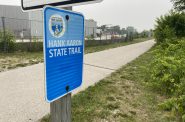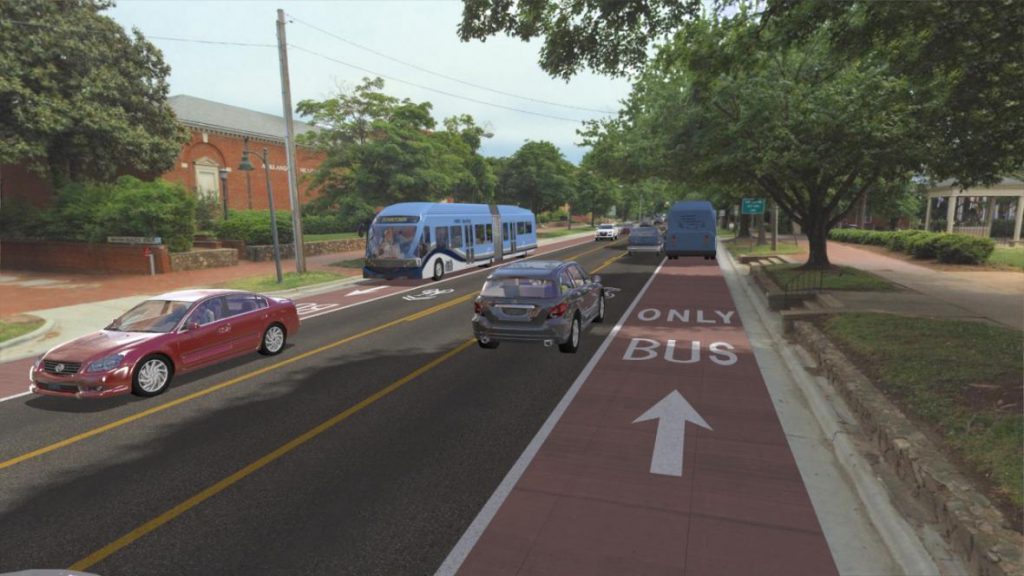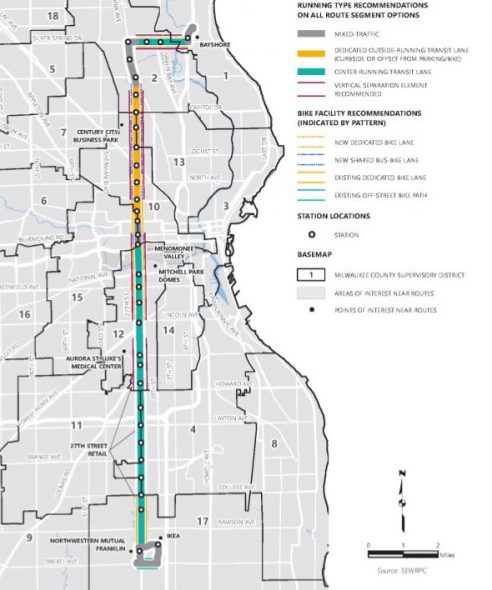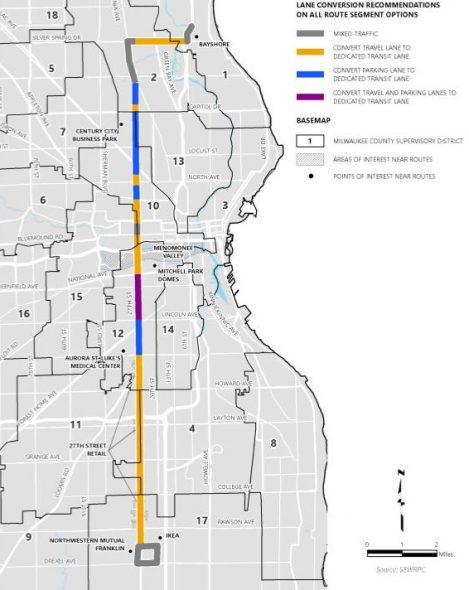County Must Decide On North-South BRT
Project could be transformative, but $148 million price tag nearly twice that of East-West BRT.
The Milwaukee County Board will soon have to consider whether or not the county should pursue a new Bus Rapid Transit (BRT) project running north and south along 27th Street corridor. That won’t be easy.
Planners from Southeastern Wisconsin Regional Planning Commission (SEWRPC) recently presented them with a recommended plan, one that county transportation officials are ready to submit for federal funding.
Milwaukee County Executive David Crowley gave the greenlight to study potential transit enhancements along the corridor in his first budget – 2021. Since then, SEWRPC has been evaluating various transit technologies and routes for improved transit in the corridor.
After deciding on BRT with battery electric buses in October 2021, planners with SEWRPC recently presented a recommended transit project, out of six possible alternatives.
This project would have an 18-mile BRT line – 84% of which has a dedicated bus lane – running from Bayshore in the North along W. Silver Spring Dr. to N. 27th street, then running all the way down 27th St. to W. Drexel Ave. where a loop would run past the Northwestern Mutual campus in Franklin and the Ikea store in Oak Creek.
The estimated project cost for this alternative, $148 million, was the cheapest of six presented at a meeting of the board’s Transportation, Public Works and Transit Committee meeting on Tuesday, July 12. But it would still be nearly double the cost of the East-West BRT line currently being constructed between downtown Milwaukee and the Milwaukee Regional Medical Complex in Wauwatosa.
BRT is intended to provide faster, more reliable transit through a mix of dedicated lanes and signal priority along the route.
The recommended plan for the 27th street corridor would have 63 BRT stations, with platforms that allow for level boarding, larger bus shelters with seating, off-board ticketing and real-time bus schedules and arrival times.
SEWRPC is recommending that some sections of dedicated lanes have a physical infrastructure built to separate it from the normal traffic lane, be it a curb, bollards or both.
On stretches of the corridor where there is a boulevard, or median running down the center, SEWRPC believes there is an opportunity to build a bus lane that runs down the center of the street, with BRT stations in the middle of the road. This also opens the door to potential cost savings during project development by having shared stations, where one stop serves both directions of travel.
Given that Battery Electric Buses were selected for the East-West BRT project, SEWRPC has also picked BEB’s as the recommended vehicle for the North-South project. It estimated 24 electric buses would be needed to run the service.
But Will The Board Support It?
In order to complete this project, MCDOT will need to secure federal funding through the Federal Transit Administration’s (FTA) Capital Investment Grant (CIG) program. This is how the county funded the East-West BRT project.
A grant under the CIG program would cover 80% of the project costs, requiring a 20% match from the county – or approximately $30 million given the estimated project costs.
This is where the board comes in. This project represents a major financial commitment for the county, which has myriad competing financial priorities and projects. On top of that, a recent five-year Financial Forecast by the Milwaukee County Comptroller found that the transit system is headed for a budget deficit of $32.9 million in 2025. “We anticipate that a transit reduction in service, infrastructure and ultimately staffing could be on the horizon,” Donna Brown-told the committee.
When Brown-Martin’s department developed a list of possible strategies for closing this gap, eliminating or deferring the North-South BRT project was one such strategy, but she downplayed it: “That is not something we want to do,” Brown-Martin said.
“Denial of investment in minority and lower income projects, particularly with this being the highest ridership route in the county, is of significant concern,” she said. It would also be a politically unpopular option.
To work toward reducing the project costs, MCDOT has offered that it could pursue clean diesel buses for the vehicles along the route instead of BEB’s. This would lower the project cost by approximately $18 million, thus reducing the county contribution by $3.6 million.
The average cost for a BEB is $1.2 million compared to approximately $600,000 for clean diesel. BEB’s also require more buses, because of the time required to charge them, Brown-Martin said. The project would only need 18 clean-diesel buses compared to the 24 BEB’s needed to operate the service.
Putting off the project would affect the county’s ability to secure funding, disrupt the planned linkage to the East-West BRT, and remove the project’s eligibility to receive mitigation funding from the state’s Interstate 94 expansion project.
Within a half mile of the 27th Street corridor 63% of residents live in poverty, one in five families are without a car and 76% of residents are people of color, according to a report by MCTS. This is a major factor in the county’s decision to improve transit along this corridor, and it will likely improve their standing when seeking a federal grant.
“I think our chances are damn good,” Brown-Martin said.
She added that it also enjoys significant political support.
“You have the support of the governor’s office right now, they like this project, Wisconsin DOT has been working with us… SEWRPC, this is part of their overall long range plan and they have been a key player in this initiative,” she said. “You have two congressional members who are very supportive of this project; and whenever briefings are done on this with either Senator [Tammy] Baldwin or Congresswoman [Gwen] Moore, the first thing they ask us is what’s the status of my project.”
More about the North-South Transit Study
- Transportation: MCTS Halting Plans for Second Bus Rapid Transit Route - Graham Kilmer - Aug 16th, 2024
- Transportation: Make Your Opinion Known On Second BRT Line - Graham Kilmer - Mar 8th, 2024
- Transportation: MCTS Seeking Board Approval For 27th Street BRT Line - Graham Kilmer - Feb 23rd, 2024
- Transportation: 27th Street Rapid Bus Route Would Launch In 2028 - Graham Kilmer - Dec 6th, 2023
- MKE County: Proposed North-South BRT Line Loses Southern Anchor - Graham Kilmer - Feb 9th, 2023
- Transportation: North-South BRT Plans Advancing in 2023 - Graham Kilmer - Jan 25th, 2023
- Transportation: Proposed Route for North-South BRT Line Unveiled - Jeramey Jannene - Sep 16th, 2022
- Transportation: County Must Decide On North-South BRT - Graham Kilmer - Jul 19th, 2022
- Transportation: Milwaukee Studying Second BRT Line - Jeramey Jannene and Graham Kilmer - Oct 25th, 2021
- Transportation: 27th Street Study Seeks Public Input - Graham Kilmer - Apr 2nd, 2021
Read more about North-South Transit Study here
Political Contributions Tracker
Displaying political contributions between people mentioned in this story. Learn more.
MKE County
-
RNC Will Cause Some County Services To Be Moved to Wauwatosa
 Jul 12th, 2024 by Graham Kilmer
Jul 12th, 2024 by Graham Kilmer
-
Hank Aaron State Trail Will Be Closed For RNC, State Fair
 Jul 12th, 2024 by Graham Kilmer
Jul 12th, 2024 by Graham Kilmer
-
MCTS Designing New Bus Shelters
 Jul 10th, 2024 by Graham Kilmer
Jul 10th, 2024 by Graham Kilmer
Transportation
-
MCTS Adds 28 New Buses
 Jul 13th, 2024 by Graham Kilmer
Jul 13th, 2024 by Graham Kilmer
-
MCTS Designing New Bus Shelters
 Jul 10th, 2024 by Graham Kilmer
Jul 10th, 2024 by Graham Kilmer
-
MCTS Updates RNC Bus Detours To Better Serve Downtown, Riders
 Jul 9th, 2024 by Jeramey Jannene
Jul 9th, 2024 by Jeramey Jannene

























It’s July 30th – missed this on the 19th, but for the archive readers, here goes –
Why are in-service buses being charged at the end of the line?
Somewhere someone by now has a roll-on roll-off solution to this delay. My memory says a Wisconsin company is doing this now by combining smaller batteries into larger modules. I could be wrong on details but the concept is out there. For 24 buses, I would think the manufacturer might find this to be a sales-boosting feature, reduce the price, and amortize it over future sales.
Speaking of prices, they’ve been misrepresented in the article as costs. Price is an element in cost. Price plus other factors through time give cost, and cost is only one side of the equation – the other is benefit.
The net cost of diesel buses is likely to be greater then the electrics – the cost difference is shifted to the public’s ledgers in the form of health factors and maybe even more so as climate factors. Diesel buses will have an ever increasing cost as fossil fuel prices rise and a decreasing resale value as fossil fuels fade in availability and public acceptance.
Another factor may be future government grants and subsidies shunning fossil fuels.
It’s possible that developments in hydrogen powered engines may relieve this situation to a small or even large degree, but when?